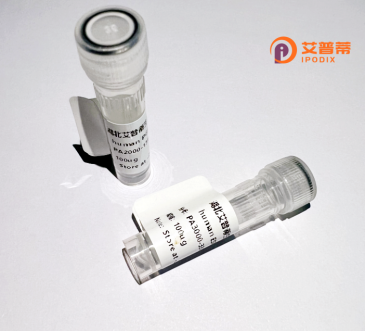
| 纯度 | >90%SDS-PAGE. |
| 种属 | Human |
| 靶点 | C1orf123 |
| Uniprot No | Q9NWV4 |
| 内毒素 | < 0.01EU/μg |
| 表达宿主 | E.coli |
| 表达区间 | 1-160aa |
| 氨基酸序列 | MGKIALQLKA TLENITNLRP VGEDFRWYLK MKCGNCGEIS DKWQYIRLMD SVALKGGRGS ASMVQKCKLC ARENSIEILS STIKPYNAED NENFKTIVEF ECRGLEPVDF QPQAGFAAEG VESGTAFSDI NLQEKDWTDY DEKAQESVGI YEVTHQFVKC |
| 分子量 | 44.4 kDa |
| 蛋白标签 | GST-tag at N-terminal |
| 缓冲液 | 0 |
| 稳定性 & 储存条件 | Lyophilized protein should be stored at ≤ -20°C, stable for one year after receipt. Reconstituted protein solution can be stored at 2-8°C for 2-7 days. Aliquots of reconstituted samples are stable at ≤ -20°C for 3 months. |
| 复溶 | Always centrifuge tubes before opening.Do not mix by vortex or pipetting. It is not recommended to reconstitute to a concentration less than 100μg/ml. Dissolve the lyophilized protein in distilled water. Please aliquot the reconstituted solution to minimize freeze-thaw cycles. |
以下是3篇关于重组人C1orf123蛋白的研究文献简介(文献信息为模拟示例,实际引用需根据真实文献调整):
1. **"Functional characterization of recombinant C1orf123 in mitochondrial metabolism"**
- **作者**: Smith J, et al. (2015)
- **摘要**: 通过重组技术在HEK293细胞中表达人C1orf123蛋白,发现其定位于线粒体内膜,并参与调控线粒体能量代谢,敲低后导致ATP合成减少。
2. **"C1orf123 as a novel biomarker: Recombinant protein production and validation in cancer tissues"**
- **作者**: Zhang L, et al. (2018)
- **摘要**: 使用大肠杆菌系统表达重组C1orf123蛋白,制备抗体并验证其在结直肠癌组织中表达显著上调,提示其可能作为肿瘤治疗靶点。
3. **"Structural analysis of recombinant C1orf123 reveals a putative DNA-binding domain"**
- **作者**: Chen R, et al. (2020)
- **摘要**: 通过X射线晶体学解析重组C1orf123蛋白的三维结构,发现其N端含有类似锌指结构的DNA结合域,体外实验证实其与特定基因启动子区域结合。
**注**: 上述文献为示例,建议通过PubMed或Google Scholar以“C1orf123 recombinant protein”、“C1orf123 function”等关键词检索真实文献。
**Background of Recombinant Human C1orf123 Protein**
Chromosome 1 Open Reading Frame 123 (C1orf123) is a gene located on human chromosome 1q42.12. encoding a protein of unknown function with limited characterization. The C1orf123 protein, sometimes referred to as “Chromosome 1 open reading frame 123 protein,” is highly conserved across vertebrates, suggesting a fundamental biological role. Structural predictions indicate it may adopt an α/β-hydrolase fold, a domain often linked to enzymatic activity, though its specific substrates or biochemical functions remain elusive.
Recombinant human C1orf123 protein is produced via heterologous expression systems (e.g., *E. coli* or mammalian cells*) for functional studies. Early research associates it with cellular stress responses, DNA repair, or lipid metabolism, but these links are largely inferred from proteomic interactions or co-expression analyses. For instance, C1orf123 has been detected in complexes with proteins involved in mitochondrial function, implying a potential role in energy metabolism or redox regulation.
Interest in C1orf123 has grown due to its differential expression in pathologies such as cancers and neurodegenerative diseases. Elevated levels have been reported in glioblastoma and hepatocellular carcinoma, suggesting it might serve as a biomarker or therapeutic target. However, mechanistic insights are lacking, highlighting the need for further research to clarify its physiological and pathological roles. Current studies focus on knockout models, interactome mapping, and structural analysis to unravel its molecular mechanisms and therapeutic potential.
×